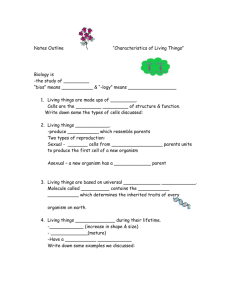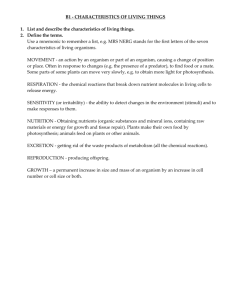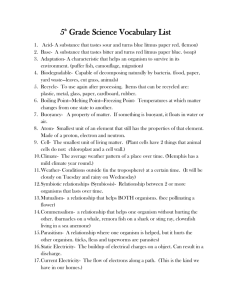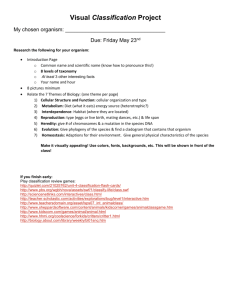Document
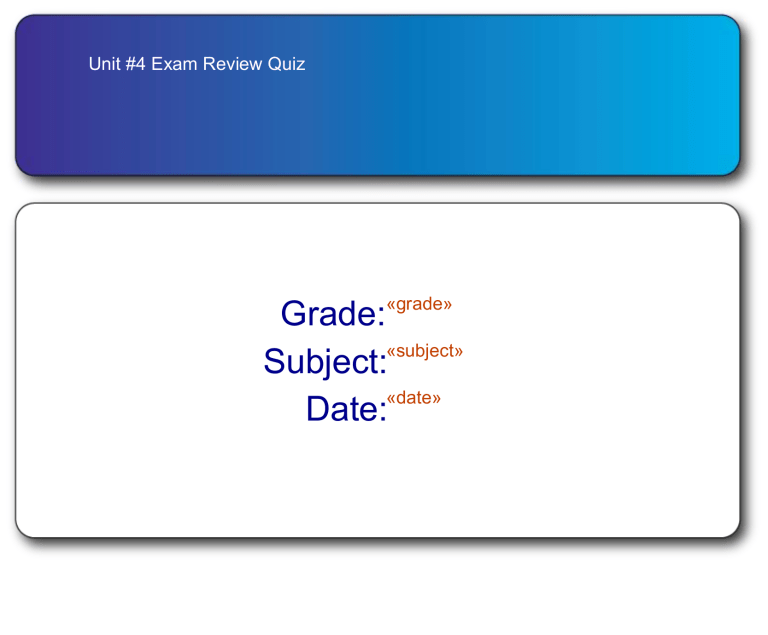
Unit #4 Exam Review Quiz
Grade:
«grade»
Subject:
«subject»
Date:
«date»
1 A gastrovascular cavity is best described as a pit or a sack in which food in inserted to be digested and diffused prior to being ejected back out of the same orifice. Which of the following has the best demonstration of a GVC:
C
D
A
B
Porifera
Humans
Echinoderms
Cnidarians
2 Which of the following is true when considering the water flow through a
Porifera:
C
D
A
B
Water flows in the ostia & out the oscullum
Water flows in the oscullum and out the ostia
Water flows in the choanocyte & out the ostia
Water flows in the choanocyte & out the amoebocytes
3 Which chemical is predominantly responsible for acid rain:
A
B
C
D sulfur dioxide carbon dioxide chlorine dioxide methane gas
4 The greenhouse effect involves:
A
B
C
D energy from the sun being trapped within the atmosphere & warming an area energy from the sun being trapped within the atmosphere & cooling the area energy from the sun causing carbon dioxide to turn into a solid energy from the sun converting halides into noble gases
5 While you are walking along a beach you suddenly feel a stinging pain in your foot. You look down to see a ManO’-War (similar to a jellyfish) attached to your stinging foot, and at the same time you notice that the toes on your foot begin to go numb. You were stung by the _________ of the ManO’-War and it injected a ___________ into your foot.
C
D
A
B
Tentacle, hemotoxin
Nematocyst, neurotoxin
Nematocyst, hemotoxin
Tentacle, neurotoxin
6 Cnidarians are polymorphic. Their two different stages are called:
A
B
C
D
Asexual and hermaphroditic
Asexual and sexual
Polyp and medusa
Polyp and asexual
7 Amebocytes help digest food and diffuse the nutrients to which of the following types of organisms:
C
D
A
B
Porifera
Cnidaria
Echinoderms
Choanocytes
8
C
D
A
B
Detrivores get their energy from:
Using photosynthesis to create glucose
Consuming living organisms to create ATP
Using chemical, such as heavy metals, to create energy
Consuming dead tissue to create ATP
9 Which of the following organisms would be best fit to survive within an intertidal zone:
A
B
C
D
An organism that can grow rapidly & defend itself well when exposed to consistent amount of dissolved oxygen
An organism that can withstand drastic changes in temperature, pH, and pressure
An organism that has a shell to prevent dehydration & limbs strong enough to move itself without the buoyant force of water
An organism that has so few cell layers that it only needs to buoyant force of water to stay suspended within the water column
10 Which of the following gives a porifera its rigid structure:
A
B
C
D ostia choanocytes spongin spicules
11 Which of the following describe a thermocline that would be found in a lentic body of water:
A
B
C
D
A gradual decline in the temperature of an ocean that is directly connected to the decline of sunlight within the body of water
A gradual decline in pressure of an ocean that is directly connected to the tides
The warm upper layer of water found in a lake
A zone in a lake where the temperature of the water changes rapidly
12 All of the following are true about zooxanthellae EXCEPT:
A
B
C
D
Zooxanthellae are responsible for the color in many coral polyps
Zooxanthellae are responsible for the majority of energy within many coral polyps
Zooxanthellae replication is responsible for coral bleaching
Zooxanthellae are symbiotes that live within many Cnidaria
13 In an aquarium containing a jellyfish a student knocks over a toxic sample of chlorine indicator. This indicator splashes into the water directly above the jellyfish and the jellyfish begins to move to the opposing side of the aquarium. The receptor most likely responsible for this detection is a(an):
A
B
C
D
Photoreceptor
Chemoreceptor
Ocelli
Statocyst
14 Which of the following organisms would be best fit to survive within an intertidal zone:
A
B
C
D
An organism that can grow rapidly & defend itself well when exposed to consistent amount of dissolved oxygen
An organism that can withstand drastic changes in temperature, pH, and pressure
An organism that has a shell to prevent dehydration & limbs strong enough to move itself without the buoyant force of water
An organism that has so few cell layers that it only needs to buoyant force of water to stay suspended within the water column
15 You would be able to find a large quantity of phytoplankton in a(n)
A
B
C
D
Eutrophic Lake
Oligotrophic Lake
2nd Order Stream
Headwaters
16 All of the following are representative of radial symmetry, EXCEPT:
A B
C D
17 When a cnidarian releases medusa copies off of the top of the organism, this is best demonstrating
A
B
C
D
Sexual reproduction
Asexual reproduction
Hermaphroditic reproduction
This is a defense mechanism addressing the difficulty of finding a mate
18 One advantage of a complete digestive system
(1-way) over an incomplete digestive system
(2-way) is that an organism with a complete system:
A
B
C
D
Must pause to eject waste through its mouth prior to eating a food source larger than its’ GVC
Can continue to consume food without having to eject that food through the same orifice that it is consuming food
Must input food through multiple orifices while ejecting waste out of similar orifices
An organism can simply diffuse nutrients through the thin tissues surrounding the organism
19 Porifera are made up of four different cells.
Which of the following is NOT one of those cells:
A
B
C
D
Choanocytes
Amoebocytes
Spongin
Oscullum
20 When a bacterium is stressed it will form a ________ in an attempt to keep its offspring alive.
A
B
C
D
Spore
Gemmule
Capsid
Cyst
21 An example of hermaphroditic reproduction would be:
A A Platyhelminthes tearing itself in two on a sharp object and then regenerating into two organisms
B A star fish being cut in half by a fisherman and regenerating once tossed back into the water
C Two medusas releasing sperm and egg and those gametes intermingling and forming offspring
D A Porifera releasing sperm and egg and those gametes intermingling and forming offspring
22 The number of organisms of one species that live in a specific area defines:
A
B
C
D a community an ecosystem a population a biome
23 Cnidarian’s sexual stage is called:
C
D
A
B
Polyp
Jellyfish
Anemone
Medusa
24 When a porifera is stressed it will form a ________ in an attempt to keep its offspring alive.
A
B
C
D spore gemmule capsid cyst
25 Which of the following is FALSE when considering global freshwater:
A
B
C
D
It covers around 1% of the planet’s surface
It contains more biodiverse species than can be found in saltwater
The concentration of dissolved salts within freshwater is less than
1%
Glaciers, rivers, wells, and aquifers are all examples of freshwater
26 Which of the following is a logical progression of energy flow:
A
B
C
D
Zooplankton --> phytoplankton --> nekton
Phytoplankton --> zooplankton --> nekton
Nekton --> zooplankton --> phytoplankton
Benthic --> zooplankton --> phytoplankton
27 Which of the following is UNTRUE about a predator/prey relationship:
A
B
C
D as prey increases, predators will increase as predators increase, prey decreases as predators increase, prey increases as prey decreases, predators will decrease
A
B
C
D
28 Which of the following sections represents a population growing without any limiting factors:
29 Which of the following does NOT describe an invasive species:
A
B
C
D
Dandelions are able to quickly disperse across a field by the movement of wind & small contact with animals.
Asian carp are aggressive omnivores
European rabbits are able to survive a wide range of temperatures
Fancy guppies can multiply quickly in a narrow range of temperatures
& pH
30 The destruction of the ozone layer is caused by
C
D
A
B carbon dioxide methane gas
CFCs
UV radiation
31 While participating in a geological survey, you measure from the high-tide mark to the edge of the continental shelf in an area off of the
Florida Keys. You measured:
A
B
C
D
The continental shelf
The intertidal zone
The benthic zone, where the majority of species exist in the oceans
The coastal zone
32 Which of the following would occur in all the choanocytes inside a Porifera were to suddenly die:
A
B
C
D
The organism would be unable to reach a medusa stage
Water movement through the organism would stop
The organism would grow asymmetrically
The spicules within the organism would rapidly grow to take the place of the choanocytes
33 Cnidarian’s respirate in a process that can be best described as:
A
B
C
D
Active
Through diffusion
Using the GVC
Hermaphroditic
34 Which stage of Porifera is this organism mobile?
C
D
A
B
Medusa
Polyp
Larvae
Asexual bud
35 Which of the following describes a population that is in decline:
A
B
C
D
The population growth chart would increase with a steady slope
The population growth chart would exponentially increase
Birth Rate = Death Rate
Birth Rate < Death Rate
